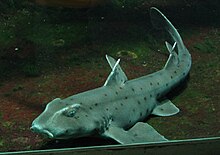Heterodontiformes
| Bullhead shark Temporal range: 183–0 Ma Early Toarcian to Present. |
|
|---|---|
 |
|
| Horn shark, Heterodontus francisci | |
| Scientific classification | |
| Kingdom: | Animalia |
| Phylum: | Chordata |
| Class: | Chondrichthyes |
| Subclass: | Elasmobranchii |
| Superorder: | Selachimorpha |
| Order: |
Heterodontiformes L. S. Berg, 1940 |
| Family: |
Heterodontidae J. E. Gray, 1851 |
| Genus: |
Heterodontus Blainville, 1816 |
| Species | |
|
See text. |
|
See text.
The bullhead sharks are a small order (Heterodontiformes) of basal modern sharks (Neoselachii). The nine living species are placed in a single genus, Heterodontus, in the family Heterodontidae. All are relatively small, with the largest species reaching just 1.65 metres (5.5 ft) in maximum length. They are bottom feeders in tropical and subtropical waters.
The Heterodontiforms appear in the fossil record in the Early Jurassic, well before any of the other Galeomorphii, a group that includes all modern sharks except the dogfish and its relatives. However, they have never been common, and their origin probably lies even further back.
The bullhead sharks are morphologically rather distinctive. The mouth is located entirely anterior to the orbits. Labial cartilages are found in the most anterior part of the mouth. Nasoral grooves are present, connecting the external nares to the mouth. The nasal capsules are trumpet-shaped and well-separated from orbits. Circumnarial skin folds are present, but the rostral process of the neurocranium (braincase) is absent, although a precerebral fossa is present. Finally, the braincase bears a supraorbital crest.
The eyes lack a nictitating membrane. A spiracle is present, but small. The dorsal ends of the fourth and fifth branchial arches are attached, but not fused into a "pickaxe" as in lamniform sharks. Heterodontiforms have two dorsal fins, with fin spines, as well as an anal fin. The dorsal and anal fins also contain basal cartilages, not just fin rays.
Bullhead Sharks have distinctive small spikes on the front of their dorsal fins. These are rumoured to be poisonous, but no further scientific tests have been done to prove this rumor true or false.
...
Wikipedia
